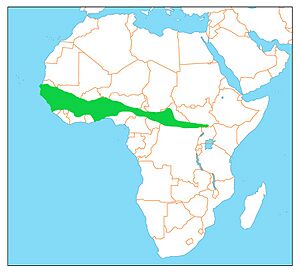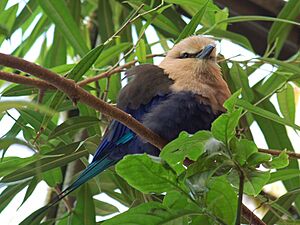Blue-bellied roller facts for kids
Quick facts for kids Blue-bellied roller |
|
|---|---|
 |
|
| Pair in The Gambia | |
| Conservation status | |
| Scientific classification | |
| Genus: |
Coracias
|
| Species: |
cyanogaster
|
 |
|
| Geographic distribution shown in green | |
The blue-bellied roller (Coracias cyanogaster) is a colorful bird from the roller family. It lives in a narrow part of Africa, from Senegal to the northeast Democratic Republic of the Congo. These birds usually stay in one place, only moving a little bit during different seasons. They like to live in moist savannah areas with tall Isoberlinia trees.
Contents
What is the Blue-Bellied Roller?
Naming the Blue-Bellied Roller
The blue-bellied roller got its scientific name, Coracias cyanogaster, in 1816. A French scientist named Georges Cuvier gave it this name. He based it on earlier descriptions by another scientist, François Levaillant.
The name cyanogaster comes from two old Greek words. Kuanos means "dark-blue," and gastēr means "belly." So, its name literally means "dark-blue belly." Levaillant first thought the bird came from the island of Java. But later, it was found that the bird actually lives in West Africa. The first official place where it was found was in Senegal. This bird is a single species, meaning there are no different types or subspecies of it.
What Does the Blue-Bellied Roller Look Like?
The blue-bellied roller is a large bird, about the size of a jackdaw. It measures about 28 to 30 centimeters (11 to 12 inches) long. Its back is a very dark brown color. The head, neck, and chest are a creamy white color. The rest of its feathers are mostly blue.
Adult blue-bellied rollers have special tail feathers that are about 6 centimeters (2.4 inches) long. These long feathers are called tail streamers. Both male and female birds look similar. Young birds, called juveniles, look a bit duller than the adults.
When the blue-bellied roller flies, it's quite amazing to watch. It flies straight and strong. The bright blue colors of its wings stand out against its dark back and cream-colored head. Its long tail streamers trail behind it as it flies. The call of this bird is a harsh, clicking sound, like "ga-ga-ga."
Where Do Blue-Bellied Rollers Live?
Habitat and Location
This bird is common in warm, open areas that have some trees. You can often see these rollers sitting high up. They perch on trees, fence posts, or even overhead wires. They sit there like large shrikes, watching for food. They mainly eat grasshoppers and other big insects.
How Do Blue-Bellied Rollers Behave?
Nesting and Display
The blue-bellied roller has a special way of flying to attract a mate. It does a display flight that looks a bit like a Northern lapwing. It twists and turns in the air. This twisting and turning is how the "roller" birds got their name. These birds build their nests in holes inside trees. They use natural tree cavities for their homes.
Is the Blue-Bellied Roller Endangered?
Conservation Status
The blue-bellied roller is found over a very large area and is quite common. Because of this, it is listed as a Least Concern species by the IUCN Red List. This means that its population is stable and it is not currently at risk of extinction.
Blue-Bellied Rollers in Zoos
Living in Captivity
Some zoos, open-air aviaries, and other educational places keep blue-bellied rollers. There have been times when these birds have escaped from captivity. When they escape, they can sometimes adapt to the local environment. For example, in the Nepalganj area of Joka, Kolkata, two blue-bellied rollers were seen in May 2023. They had adapted well to living there.



